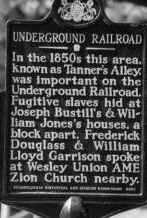

Study Areas:
Underground Railroad
Underground Railroad Chronology
Learn More
1845: Kitty Payne and her family are kidnapped
1845, July 24 The Kitty Payne family, consisting of a mother and three children who were manumitted in Maryland and relocated to northern Adams County, was kidnapped by a gang led by Thomas Finnegan, and taken to reenslavement in Maryland. Finnegan was eventually captured on a subsequent foray into Adams County and tried, found guilty, and sentenced to five years at Eastern Penitentiary. The Payne family was eventually able to return to Adams County. (Carlisle Herald & Expositor, 6 August 1845)
From the Carlisle Herald
Kidnapping in Adams County!
The last Gettysburg "Star," says that a family of colored persons,--a mother and her children--who were manumitted about two years since by a lady of Maryland, and took up their residence near Bendersville, in Adams county, were last week forcibly abducted by a gang of ruffians, headed by a man named Finnegan, who after gagging and tying them so as to prevent their giving any alarm, carried them back to slavery. The Star animadverts in severe but just terms of indignation upon this villainous outrage upon the liberties of this free colored family. It is added that measures are about to be taken to have the affair legally investigated, which it is to be hoped will be successful in restoring these poor creatures to freedom and visiting just punishment upon the perpetrators of the outrage. The lady who emanicpated the family formerly resided near Hagerstown, Maryland, and teh men-stealers it is supposed came from the same quarter.
Sources
Carlisle Herald and Expositor, Wednesday, 06 August 1845
Learn More
For more on Kitty Payne and her family, see the historical marked dedicated to the event.
Now Available
The Year of Jubilee
Vol. 1: Men of God and Vol. 2: Men of Muscle
by George F. Nagle
The Year of Jubilee is the story of Harrisburg'g free African American community, from the era of colonialism and slavery to hard-won freedom.
 Volume One, Men of God, covers the turbulent beginnings of this community,
from Hercules and the first slaves, the growth of slavery in central
Pennsylvania, the Harrisburg area slave plantations, early runaway
slaves, to the birth of a free black community. Men of God is a detailed
history of Harrisburg's first black entrepreneurs, the early black
churches, the first black neighborhoods, and the maturing of the social
institutions that supported this vibrant community.
Volume One, Men of God, covers the turbulent beginnings of this community,
from Hercules and the first slaves, the growth of slavery in central
Pennsylvania, the Harrisburg area slave plantations, early runaway
slaves, to the birth of a free black community. Men of God is a detailed
history of Harrisburg's first black entrepreneurs, the early black
churches, the first black neighborhoods, and the maturing of the social
institutions that supported this vibrant community.
It includes an extensive examination of state and federal laws governing slave ownership and the recovery of runaway slaves, the growth of the colonization movement, anti-colonization efforts, anti-slavery, abolitionism and radical abolitionism. It concludes with the complex relationship between Harrisburg's black and white abolitionists, and details the efforts and activities of each group as they worked separately at first, then learned to cooperate in fighting against slavery.
Non-fiction, history. 607 pages, softcover.
 Volume Two, Men of Muscle takes the story from 1850 and the Fugitive Slave Law of 1850, through the explosive 1850s to the coming of Civil War
to central Pennsylvania. In this volume, Harrisburg's African American
community weathers kidnappings, raids, riots, plots, murders, intimidation,
and the coming of war. Caught between hostile Union soldiers and deadly
Confederate soldiers, they ultimately had to choose between fleeing
or fighting. This is the story of that choice.
Volume Two, Men of Muscle takes the story from 1850 and the Fugitive Slave Law of 1850, through the explosive 1850s to the coming of Civil War
to central Pennsylvania. In this volume, Harrisburg's African American
community weathers kidnappings, raids, riots, plots, murders, intimidation,
and the coming of war. Caught between hostile Union soldiers and deadly
Confederate soldiers, they ultimately had to choose between fleeing
or fighting. This is the story of that choice.
Non-fiction, history. 630 pages, softcover.
Order print copies at Amazon by clicking the book covers, above.
